These TS 7th Class Science Important Questions 12th Lesson Reproduction in Plants will help the students to improve their time and approach.
TS 7th Class Science Important Questions 12th Lesson Reproduction in Plants
Question 1.
Write the tabular form of vegetative reproduction in some plants with examples.
Answer:
| Plant | Part of the plant |
| 1. Sweet potato, dahlia, carrot, turnip,radish. | 1. New plants grow from the modified root. |
| 2. Potato. | 2. New plants grow from eyes in the tuber which is a modified stem. |
| 3. Onion, garlic, tuberose, lilies, gladioli. | 3. New plants grow from bulbs, or corms (gladioli), which are modified stems. |
| 4. Bryophyllum (sprout leaf plant), begonia. | 4. New plants grow from buds on the leaf. |
| 5. Sugarcane. | 5. Stem grows roots at the nodes. |
| 6. Mint. strawberry, chrysa rithemum, raspberry. | 6. Stem creeps along the ground and strikes roots at the nodes. |
![]()
Question 2.
Explain the structure of stamen of flower.
Answer:
- The self elongated structures attached to the petals of a flower are called stamens.
- The stamens are collectively called as androeciurn.
- There is a bulb like structure at the top of each stamen is called pollen sac or anther.
- Just below it a fine whitish thread like structure called filament attaches the anther to the petal.

Question 3.
Explain the structure of gynoecium of flower.
Answer:
- Right on the thalamus is seated a bulb like structure called ovary.
- Just above it, there is a fine tube like structure called style.
- The style is ending in a flat bead like structure called stigma.
- This whole structure from ovary to stigma is the pistil or gynoecium.
Question 4.
What is meant by fertilisation?
Answer:
Fusion of units of male and female parts to form a structure called as zygote is called “Fertilisation”.
![]()
Question 5.
Name the parts of the following plants through which vegetative propagation occurs.
i. Carrot
ii. Garlic
iii. Begonia
iv. Mint
Answer:
i. Carrot: New plants grow from modified root.
ii. Garlic: New plants grow from bulb.
iii. Begonia: Buds on the leaf develops as new plant.
iv. Mint: Stem creeps along the ground and strikes roots at the node.
Question 6.
Define vegetative propagation.
Answer:
Production of new plants from vegetative parts such as root, stem and leaf is known as vegetative propagation.
![]()
Question 7.
Anu is discussing about pollination and reproduction in plant organisms with her teacher. What questions she might have asked her teacher? Frame some of them.
Answer:
- Why plants are dependent on pollination for reproduction?
- What type of pollination occurs in plants?
- What is the relationship between pollination and reproduction?
- Is pollination the only way for reproduction in plants?
Question 8.
If pollination is not done in the flowering plants, what would be the consequenes?
Answer:
Pollination is the key factor for sexual reproduction in plants. Without pollination, flowering plants can’t produce new plants with new characters. Moreover, population will decrease due to less occurrence of sexual reproduction.
Question 9.
Tabulate the observation you made in transeverse section of Datura flower.
| Circle whorls No | Name of the circle whorls | Parts observed in the circle whorls |
Answer:
| Circle whorls No | Name of the circle whorls | Parts observed in the circle whorls |
| 1. | Calyx | Sepals – green coloured CUl) like structures |
| 2. | Corolla | Petals – white coloured cup like structures |
| 3. | Androecium | Stamens – with anther and filament. Filament attached with petals. |
| 4. | Gynoeciurn | Ovary – style, stigma |
![]()
Question 9.
Tabulate the observation you made in transeverse section of Datura flower.
| Circle whorls No | Name of the circle whorls | Parts observed in the circle whorls |
Answer:
A Datura flower is collected and dissected transversely. Floral parts are observed. They are arranged in circles.
| Circle whorls No | Name of the circle whorls | Parts observed in the circle whorls |
| 1. | Calyx | Sepals – green coloured cup like structures |
| 2. | Corolla | Petals – white coloured cup like structures |
| 3. | Androecium | Stamens – with anther and filament. Filament attached with petals. |
| 4. | Gynoecium | Ovary – style, stigma |
Question 10.
Tabulate the observations in the different flowers collected by you from the surroundings based on the given table.

Answer:

![]()
Question 11.
You might have collected the flowers of the following plants with the help of your teacher. How did you do the activity? Write the procedure and observation. Tabulate the information.
hibiscus, cucumber, bitter gourd, datura, ipomea, bottle gourd flowers.
Answer:
| S.No. | Name of the flower | Complete or incomplete flower |
Unisexual or Bisexual flower | Male or female flower |
Aim:
To observe the type of the flowers.
Requirements :
Hibiscus, cucumber, bitter gourd, datura, ipomea, bottle gourd flowers.
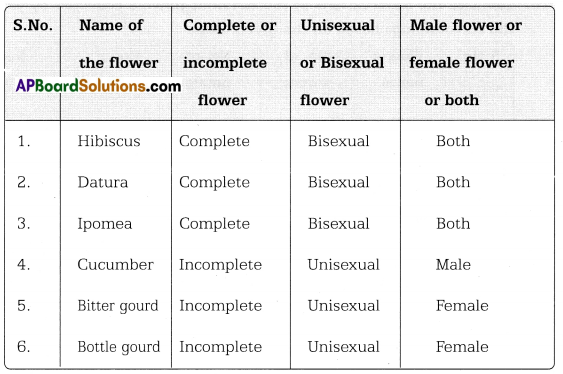
Question 12.
Tabulate the information you collected about the plants which reproduce through vegetative reproduction in your surroundings or locality
| S. No | Name of the plant | Plant part from which new |
| 1. 2. 3. 4. |
Rose Bryophyllum Ginger Potato |
Stem Leaf Stem Sunken spot of eye |
Question 13.
Draw the diagrams of different types of stamens.
Answer:

Question 14.
Draw the diagrams of types of pistils.
Answer:
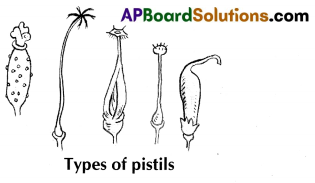
Question 15.
a. Draw the diagram of L.S of ovary in Datura.
Answer:
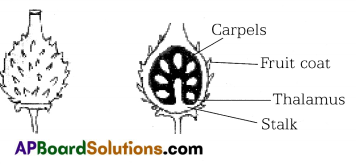
b) Draw the diagram of pistil and label the parts.
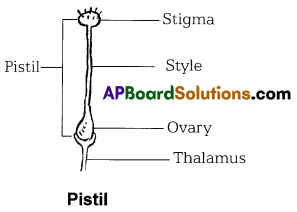
Sexual reproduction in flowering plants is essential because sexual reproduction influences the following.
- Natural selection
- Evolution of new species
- More chance of appearance of new characters.
- Development of disease resistant varieties.
![]()
Question 17.
How will vegetative propagation in lower organism become beneficiary towards human life?
Answer:
- In preparation of jilebi, yeast cells are grown up
- Yeast is used in bakery industry.
Choose the correct answer:
I. Conceptual Understanding
Question 1.
Find out the unisexual flower. ( )
A) Cucumber
B) Hibiscus
C) Ipomea
D) Datura
Answer:
A) Cucumber
Question 2.
Father of Botany who observed reproduction in plants for the first time ( )
A) Aristotle
B) Socrates
C) Whittaker
D) Theophrastus
Answer:
D) Theophrastus
Question 3.
The new plant grown from corns of ( )
A) Gladioli
B) Cano
C) Potato
D) Mint
Answer:
A) Gladioli
![]()
Question 4.
New plants grown from the roots of ( )
A) Potato
B) Strawberry
C) Dahlia
D) Mint
Answer:
B) Strawberry
Question 5.
Calyx of flower contains ( )
A) petals
B) pistil
C) sepals
D) stigma
Answer:
C) sepals
Question 6.
Corolla of flowers ( )
A) sepals
B) petals
C) pistil
D) stamen
Answer:
B) petals
Question 7.
Match the following.
i) corolla ( ) a) pistil
ii) calyx ( ) b) petals
iii) androecium ( ) c) sepals
iv) gynoecium ( ) d) stamen
A) i-a, ii-d, iii-b, iv-c
B) i-c, ii-b, iii-d, iv-a
C) i-d, ii-c, iii-a,iv-b
D) i-b, ii-c, iii-d,iv-a
Answer:
D) i-b, ii-c, iii-d,iv-a
Question 8.
The attractive colourful part of the flower ( )
A) Petals
B) Calyx
C) A and B
D) Sepals
Answer:
C) A and B
![]()
Question 9.
Find Out the bisexual flower. ( )
A) Ipomea
B) Cucumber
C) Bitter gourd
D) Bottle gourd
Answer:
A) Ipomea
Question 10.
Find out the unisexual flower. ( )
A) Hibiscus
B) Ipomea
C) Cucumber
D) Datura
Answer:
C) Cucumber
Question 11.
Transfer of pollen grain to stigma. ( )
A) Combination
B) Pollination
C) Addition
D) Vegetative propagation
Answer:
B) Pollination
Question 12.
Agents of pollination. ( )
A) Air
B) Water
C) Insects
D) Above all
Answer:
D) Above all
![]()
Question 13.
Vegetative propagation through stem is seen in ( )
A) potato
B) bryophyllum
C) tomato
D) bectroot
Answer:
A) potato
Question 14.
New plants grow from the modified root in ( )
A) begonia
B) mint
C) sweet potato
D) onion
Answer:
D) onion
II. Asking Questions and Making Hypothesis
Question 15.
Find out the odd one. ( )
A) Cucumber
B) Ipomea
C) Bottle gourd
D) Bitter gourd
Answer:
B) Ipomea
Question 16.
Lillies : modified stem:: strawberry ….. ? ( )
A) root at node
B) root at stem tip
C) stem at root
D) All the above
Answer:
A) root at node
![]()
Question 17.
One of the following is different from three. Find out ( )
A) Water melon
B) Papaya
C) Bitter gourd
D) Datura
Answer:
D) Datura
Question 18.
Insects are attracted by flowers through ( )
A) calyx
B) corolla
C) gynoecium
D) androecium
Answer:
B) corolla
III. Experimentation and Field Investigation
Question 19.
To find out the fungus, we can do simple technique with ( )
A) bread slice
B) dry fruit
C) green plants
D) grain
Answer:
A) bread slice
Question 20.
What did you observe in the inner circle of Datura flower. ( )
A) stamen
B) sepals
C) ovary
D) petals
Answer:
C) ovary
Question 21.
Depressions you found on the potato. ( )
A) Pieces
B) Fingers
C) Buds
D) Eyes
Answer:
D) Eyes
![]()
Question 22.
What is to be mixed with yeast to find out budding process? ( )
A) Chilli powder
B) Sugar
C) Lime water
D) Water
Answer:
B) Sugar
Question 23.
If we want to observe bisexual flower, we will choose this. ( )
A) Hibiscus
B) Papaya
C) Water melon
D) Bitter gourd
Answer:
A) Hibiscus
IV. Information Skills and Projects
Question 24.
Read the table and answer the following
| Plant | Part of the plant |
| tuberose, gladioli chrysenthemum, raspberry | new plants from bulb or corn roots develop at the nodes |
Q. What type of method is seen with the help of given table.
A) Sexual reproduction
B) Vegtative propagation
C) Budding
D) Regeneration
Answer:
B) Vegtative propagation
Question 25.
The bisexual flowering plant that grows in our surroundings. ( )
A) Datura
B) Mandara
C) Papaya
D) A or B
Answer:
D) A or B
![]()
Question 26.
Read the para and answer the question. After fertilization, seed develops from ovule and ovary develops into fruit. This is seen in sexual reproduction.
Q. This helps in fertilisation with ovule of flowers. ( )
A) Stamen
B) Ovary
C) Petals
D) Sepals
Answer:
A) Stamen
V. Communication through Drawing and Model Making
Question 27.
Find out the given diagram. ( )
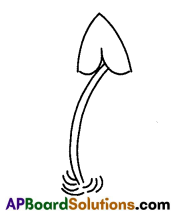
A) Ovary
B) Androecium
C) Gynoecium
D) Sepal
Answer:
B) Androecium
Question 28.
The given picture depicts of flower. ( )
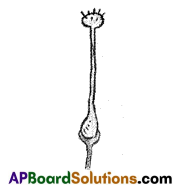
A) Gynoecium
B) Pistil
C) Androecium
D) A or B
Answer:
D) A or B
Question 29.
Name the part seen during fertilisation in flowers

A) Pollen grain ( )
B) Seed tube
C) Pollen tube
D) Style
Answer:
C) Pollen tube
![]()
VI. Appreciation and Aesthetic Sense and Values and Application to Daily Life and Concern to Bio Diversity
Question 30.
We grow large number of plants through ( )
A) vegetative propagation
B) cuttings
C) roots
D) stem
Answer:
A) vegetative propagation
Question 31.
Most of the plants are in our surrounding. ( )
A) non flowering
B) flowering
C) both A and B
D) none
Answer:
B) flowering
Question 32.
The enormous use of pesticides in the crop fields kill insects that help in……………..
A) pollination
B) fragmentation
C) plant sterilization
D) all of the above
Answer:
A) pollination